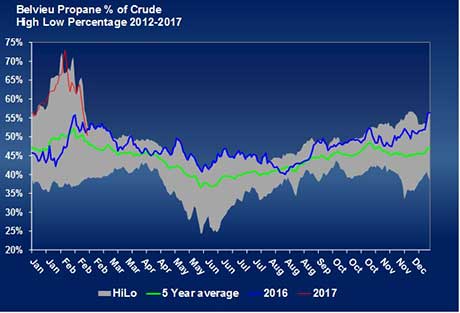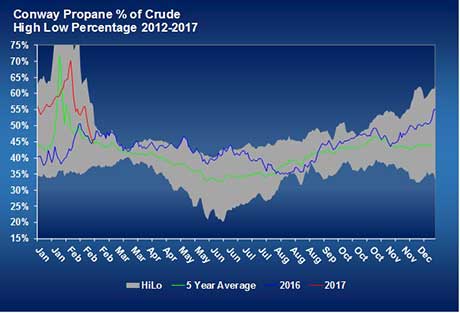Has the propane price correction gone too far?
Propane prices have been on a strong decline throughout most of February, and that decline has shown little sign of abating. Has the price correction gone too far?
Propane prices spiked in January, as domestic demand and strong export volumes rapidly pulled down inventories. Mont Belvieu propane reached a closing high of 93 cents on Feb. 2. Conway posted its closing high for the year on the same day at 89.5 cents.
In less than a month, Mont Belvieu fell 28.25 cents, losing 30 percent of its value, while Conway dropped 32.5 cents, or 36 percent of its value. Propane is now trading at its lows for the year, with Mont Belvieu at 64.75 cents and Conway at 57 cents.
With the dramatic drop, Mont Belvieu propane fell below where it was valued relative to West Texas Intermediate (WTI) crude at this point last year.
With the even sharper fall in Conway prices, propane’s value is even more below its five-year average relative to WTI crude.
Of course, as any propane retailer knows, winter weather this year has been mild. In fact, heating degree days are running below last year’s exceptionally mild winter. For the week ending Feb. 17, the last data released by the Energy Information Administration (EIA) showed domestic demand was at 1.218 million barrels per day (bpd). That was 328,000 bpd less than the same week in 2016.
As propane market participants don short pants and golf shirts instead of coats and boots, it is easy to see why a bearish bias has gripped propane markets. We worry a little that we are putting too much emphasis on domestic demand and not accepting the new paradigm that the United States is the major player in a global propane market.
During January when prices were strong, U.S. propane exports only slipped below 1 million bpd once, at 998,000 bpd during the second week of the year. This year, EIA estimated exports at an average daily rate of 1.087 million bpd. Last year over the same time frame, the rate was 707,000 bpd. That is a 380,000-bpd year-over-year increase. Export volumes are likely to slow down once winter is over in the Northern Hemisphere. However, that does not mean that export rates will not stay above last year’s rates.
U.S. propane inventory is now at 49.843 million barrels. The lowest inventory fell last year was to 62.226 million barrels. Currently, inventory is nearly 17 million barrels below where it was last year. At the same time, U.S. crude inventory is at record highs.
If we are establishing the price relationship between crude and propane, it would seem counterintuitive that propane should be valued less than it was against crude last year, given their current inventory conditions.
While the drawdown in propane inventory has certainly slowed with the falloff in domestic demand, the weekly draws are still running above the five-year average. For the week of Feb. 17, the inventory draw was 3.297 million barrels. The five-year average for that week of the year has been 2.381 million bpd.
Propane inventory is more fundamentally supportive to its value than crude inventory is to its value when compared to the same point last year. Propane exports are strong, and so far, holding well above the rates they were at this point last year. Propane inventory draws are still running at an above-average pace this year.
Those facts are why we question if valuing propane below where it was at this point last year is justified. Has the downward momentum of this price correction taken values below what is fair given current conditions? That often happens in extremely sharp corrections like what has occurred this month.
With temperatures unseasonably warm, it may be hard for a propane retailer to care much one way or the other where propane prices are overvalued or undervalued. However, these are the exact kinds of conditions that can offer the best opportunity for retailers to capture supply values that could be beneficial to them in the future. Threats and fear are strong motivators, so most propane buying occurs when prices are rising. When prices go down, buying activity tends to dry up. If we only we had a dollar for every time a propane retailer has called us in the middle of a price spike and said, “Why didn’t I buy when prices fell? It was such a great opportunity.” Yes, it was.
Call Cost Management Solutions today for more information about how Client Services can enhance your business at (888) 441-3338 or drop us an email at info@propanecost.com.


















